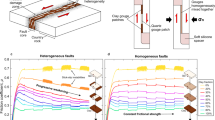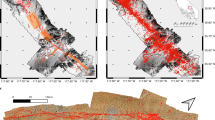Abstract
Field and laboratory observations suggest that the porosity within fault zones varies over earthquake cycles so that fluid pressure is in long-term equilibrium with hydrostatic fluid pressure in the country rock. Between earthquakes, ductile creep compacts the fault zone, increasing fluid pressure, and finally allowing frictional failure at relatively low shear stress. Earthquake faulting restores porosity and decreases fluid pressure to below hydrostatic. This mechanism may explain why major faults, such as the San Andreas system, are weak.
This is a preview of subscription content, access via your institution
Access options
Subscribe to this journal
Receive 51 print issues and online access
$199.00 per year
only $3.90 per issue
Buy this article
- Purchase on Springer Link
- Instant access to full article PDF
Prices may be subject to local taxes which are calculated during checkout
Similar content being viewed by others
References
Zoback, M. D. Phil. Trans. R. Soc. A337, 141–150 (1991).
Hickman, S. H. Rev. Geophys. 29 (suppl.), 759–775 (1991).
Lachenbruch, A. H. & Sass, J. H. J. geophys. Res. 85, 6185–6222 (1980).
Matthews, M. V. & Segall, P. J. geophys. Res. (in the press).
Lisowski, M., Prescott, W. H., Savage, J. C. & Johnston, M. J. Geophys. Res. Lett. 17, 1437–1440 (1990).
Byerlee, J. D. Pure appl. Geophys. 116, 615–626 (1978).
Morrow, C., Radney, B. & Byerlee, J. D. in Fault Mechanics and Transport Properties in Rocks (the Brace Volume) (eds Evans, B. & Wong, T. F.) 69–88 (Academic, London, 1992).
Cox, S. F. & Etheridge, M. A. J. struct. Geol. 11, 147–162 (1989).
Wannamaker, P. E. et al. J. geophys. Res. 94, 14127–14144 (1989).
Byerlee, J. D. Geophys. Res. Lett. 17, 2109–2112 (1990).
McCaig, A. M. Geology 16, 867–870 (1988).
Dick, H. J. B. et al. Proc. ODP 118, 439–538 (1991).
Rice, J. R. in Fault Mechanics and Transport Properties in Rocks (the Brace Volume) (eds Evans, B. & Wong, T. F.) 475–503 (Academic, London, 1992).
Melosh, H. J. J. geophys. Res. 84, 7513–7520 (1979).
Lachenbruch, A. H. J. geophys. Res. 85, 6097–6112 (1980).
Raleigh, C. B. in Proc. Conf. II, Experimental Studies of Rock Friction with Application to Earthquake Prediction, 291–304 (U.S. Geological Survey, Menlo Park, California, 1977).
McKenzie, D. P. & Brune, J. N. Geophys. J. R. astr. Soc. 29, 65–78 (1972).
Mead, W. J. J. Geol. 33, 685–698 (1925).
Rutter, E. H. J. geol. Soc. Lond. 140, 725–740 (1983).
Tada, R., Maliva, R. & Siever, R. Geochim. cosmochim. Acta 51, 2295–2301 (1987).
Blanpied, M. L., Lockner, D. A. & Byerlee, J. D. Geophys. Res. Lett. 18, 609–612 (1991).
Lockner, D. A. thesis, Massachusetts Inst. Technol. (1990).
Smith, D. L. & Evans, B. J. geophys. Res. 89, 4125–4135 (1984).
Morrow, C. A., Moore, D. E. & Byerlee, J. D. Mater. Res. Soc. Proc. 44, 467–473 (1985).
Blanpied, M. L., Lockner, D. A. & Byerlee, J. D. Nature 358, 574–576 (1992).
Marone, C., Raleigh, C. B. & Scholz, C. H. J. geophys. Res. 95, 7007–7025 (1990).
Morrow, C. A. & Byerlee, J. D. J. struct. Geol. 11, 815–825 (1989).
Powley, D. E. Earth Sci. Rev. 29, 215–226 (1990).
Walder, J. & Nur, A. J. geophys. Res. 89, 11539–11548 (1984).
Hobbs, B. E., Ord, A. & Teyssier, C. Pure appl. Geophys. 124, 309–336 (1986).
Sibson, R. H., Robert, F. & Poulsen, K. H. Geology 16, 551–555 (1988).
Power, W. L. & Tullis, T. E. J. struct. Geol. 11, 879–893 (1989).
Parry, W. T. & Bruhn, R. L. J. geophys. Res. 91, 730–744 (1986).
Janecke, S. U. & Evans, J. P. Geology 16, 1064–1067 (1988).
Chester, F. M., Evans, J. P. & Biegel, R. L. J. geophys. Res. (in the press).
Sibson, R. H. Pure appl. Geophys. 124, 159–175 (1986).
O'Neil, J. R. Pure appl. Geophys. 122, 440–446 (1985).
Byerlee, J. Geology (submitted).
Byerlee, J. Tectonophysics (in the press).
Angevine, C. L., Turcotte, D. L. & Furnish, M. D. Tectonics 1, 151–160 (1982).
Sleep, N. H. J. geophys. Res. 93, 10255–10272 (1988).
Jaeger, J. C. & Cook, N. G. W. Fundamentals of Rock Mechanics (Chapman and Hall, London, 1971).
Sibson, R. H. Bull. seismol. Soc. Am. 80, 1580–1604 (1990).
McKenzie, D. P. J. Petrol. 25, 713–765 (1984).
McKenzie, D. P. J. geol. Soc. Lond. 144, 299–307 (1987).
Stevenson, D. J. & Scott, D. R. A. Rev. Fluid Mech. 23, 305–339 (1991).
Haar, L., Gallagher, J. S. & Kell, G. S. NBS/NRC Steam Tables (Hemisphere, Washington, 1971).
Aydin, A. Pure appl. Geophys. 116, 913–930 (1978).
Aydin, A. & Johnston, A. M. Pure appl. Geophys. 116, 931–942 (1978).
Author information
Authors and Affiliations
Rights and permissions
About this article
Cite this article
Sleep, N., Blanpied, M. Creep, compaction and the weak rheology of major faults. Nature 359, 687–692 (1992). https://doi.org/10.1038/359687a0
Received:
Accepted:
Issue Date:
DOI: https://doi.org/10.1038/359687a0
This article is cited by
-
Role of fluid on seismicity of an intra-plate earthquake zone in Western India: an electrical fingerprint from magnetotelluric study
Earth, Planets and Space (2023)
-
Unstable Shear Slip Failure and Seismic Potential Investigation Using DEM in Underground Mining
Mining, Metallurgy & Exploration (2023)
-
Long-lived shallow slow-slip events on the Sunda megathrust
Nature Geoscience (2021)
-
Structural Changes and Electrodynamic Effects in Polymers under Fast Uniaxial Compression
Chinese Journal of Polymer Science (2021)
-
Structural control and system-level behavior of the seismic cycle at the Nankai Trough
Earth, Planets and Space (2020)
Comments
By submitting a comment you agree to abide by our Terms and Community Guidelines. If you find something abusive or that does not comply with our terms or guidelines please flag it as inappropriate.



